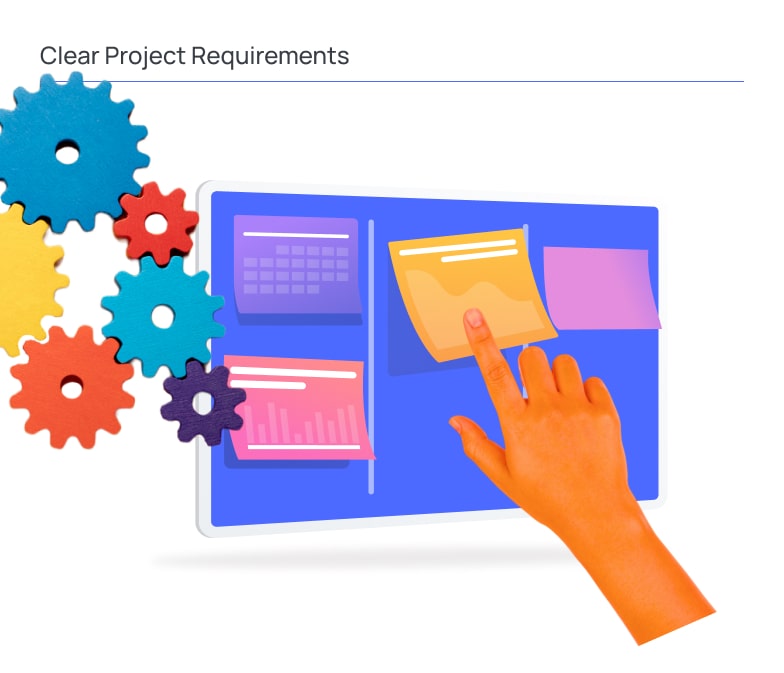How to Reduce Software Development Costs?
When addressing the expenses of building new software, understanding the major factors that might impact them will help you make more informed financial choices and get a higher ROI for your company. Here is a list of ways of how to reduce software development costs and make your project’s financial situation as profitable as possible.
Clear Project Requirements

Invest time upfront to gather detailed and transparent project requirements. This involves communication with stakeholders to understand their needs and expectations. Apply tools like user stories, use cases, and wireframes to document requirements comprehensively.
Benefits of implementing a precise project business plan for app startup:
- Alignment with Stakeholder Expectations. Clearly defined requirements help ensure that all stakeholders, including clients and development teams, have a common understanding of the project’s goals and functionalities.
- Reduced Scope Creep. Well-documented requirements serve as a reference point for controlling project scope and managing changes effectively.
- Better Communication within Teams. Developers, testers, and other team members can work more efficiently when they precisely understand what is expected from them. This reduces the likelihood of errors and misunderstandings during development.
- Improved Testing and Quality Assurance. Testers can create test cases based on the specified requirements, ensuring comprehensive coverage and accurate validation of the software against the intended functionality.
- Enhanced Client Satisfaction. Precise requirements help in managing client expectations and provide a basis for measuring project success.
- Easier Maintenance and Updates. With clear requirements documentation, new developers or team members can refer to the requirements to understand the existing functionality and make changes or improvements without ambiguity.
- Risk Mitigation. By understanding potential challenges and issues upfront, the team can proactively address them, reducing the likelihood of project delays or failures.
Agile Development Methodology
Agile is an iterative and flexible development approach. Break down the project into smaller iterations called sprints, typically 2-4 weeks long. Regularly reassess priorities and adjust development goals based on feedback. This allows for quicker adaptation to changes and ensures that the project remains aligned with business objectives. In the end, such changes can reduce the costs of the software development.
Benefits of Agile:
- Flexibility. Agile allows teams to respond quickly to changing requirements and priorities.
- Customer Satisfaction. Regular customer collaboration ensures that the delivered product meets or exceeds customer expectations.
- Faster Time-to-Market. Agile’s iterative approach enables the delivery of incremental improvements, allowing for quicker releases.
- Improved Quality. Continuous testing and integration practices in Agile contribute to higher overall software quality.
- Better Team Collaboration. Agile promotes a collaborative and transparent working environment, fostering better communication and teamwork.
- Adaptability. Agile methodologies can be adapted to different types of projects and industries, not just software development.
Open Source Technologies
Explore open-source frameworks, libraries, and tools. Platforms like GitHub host a vast array of open-source projects. Using these technologies can save on licensing fees and benefit from a community of developers contributing to and maintaining the software.
Benefits of using the open source technologies:
- Software Cost Reduction. No licensing fees; software is freely accessible.
- Community Collaboration. Global developer community for rapid improvement.
- Customization and Flexibility. Source code can be modified to suit specific needs.
- Security and Reliability. Transparent development leads to quicker identification and resolution of vulnerabilities.
- No Vendor Lock-in. Freedom to choose and switch between tools and technologies.
- Community Support. Access to forums and resources for assistance.
- Continuous Improvement. Regular updates and contributions enhance features and security.
- Leverage Existing Solutions. Reuse open source components, saving time and effort.
Outsourcing
Outsourcing involves hiring external teams or individuals to handle specific tasks. Look for reputable outsourcing partners, check their track record, and communicate clearly about expectations and project requirements. Outsourcing can be cost-effective, especially for non-core activities.
Outsourcing in software development offers several benefits:
- Cost Savings. Reduces development expenses by leveraging lower labor costs.
- Access to Global Talent. Taps into a diverse, global talent pool with specialized expertise.
- Focus on Core Competencies. Enables companies to concentrate on core functions and strategic goals.
- Flexibility and Scalability. Adapts quickly to changing project requirements without hiring challenges.
- 24/7 Development Cycle. Achieves continuous development with teams in different time zones.
- Risk Management. Distributes project risks by leveraging the expertise of outsourcing partners.
- Access to Latest Technologies. Benefits from cutting-edge tools and methodologies without in-house training.
- Reduced Management Overhead. Outsourcing providers handle project management, reducing internal burden.
Are you looking for a development team to work with?
Cobtact UsRemote Teams

Embrace remote work to tap into a global talent pool. Platforms like Upwork and Toptal allow you to find skilled professionals worldwide. Communication tools like Slack and Zoom and project management tools like Jira help maintain collaboration and coordination.
Cross-Training
Cross-training involves teaching team members multiple skills. This ensures flexibility within the team, allowing members to step in for each other when needed. It reduces dependency on individual specialists, making the team more versatile.
Automated Testing
Implement automated testing to catch bugs early in the development process. Tools like Selenium, JUnit, and TestNG can automate testing tasks, improving code quality and reducing the time and effort needed for manual testing.
Cloud Computing

Cloud computing is a technology that allows you to access and use computing resources (like servers, storage, databases, networking, software, and analytics) over the internet (the cloud) instead of owning and managing them locally. Popular cloud service providers include Amazon Web Services (AWS), Microsoft Azure, and Google Cloud Platform (GCP).
Here’s how cloud computing can benefit your software development business:
- Cost Savings. Cloud computing eliminates the need for upfront capital investment in physical hardware. You pay for the resources you use, which can help in reducing cost of software development, especially for startups.
- Global Accessibility. Cloud services are accessible from anywhere with an internet connection. This benefits a software development business with a distributed team or wants to reach a global audience.
- Speed and Agility. Cloud computing services provide on-demand resources, reducing the time it takes to deploy infrastructure. This agility allows your development team to experiment with new ideas quickly and roll out new applications faster.
- Automatic Updates. Cloud service providers handle maintenance tasks, including updates and patches. This ensures that your infrastructure and software are running on the latest versions with minimal effort from your team.
- Security Measures. Reputable cloud providers invest heavily in security measures, including encryption, access controls, and compliance certifications. Leveraging these services can enhance the security posture of your applications and data.
- Collaboration and Remote Work. Cloud-based collaboration tools and platforms facilitate remote work and cooperation among team members. This is particularly important in a software development business where teams may be distributed.
- Data Backup and Recovery. Cloud providers often offer robust data backup and recovery solutions. In the event of data loss or a disaster, you can quickly recover your data and applications.
Reusable Components
Encourage the development of reusable code components and modules. This can be achieved through well-defined APIs (Application Programming Interfaces) and shared libraries. Reusing code saves time and effort in future projects.
Continuous Integration and Deployment (CI/CD)
CI/CD pipelines automate the testing, integration, and deployment processes. Tools like Jenkins, Travis CI, and GitLab CI/CD automate repetitive tasks, reducing the risk of human error and speeding up the development cycle.
Documentation
Maintain comprehensive documentation throughout the development process. This includes design documents, API documentation, and user manuals. Documentation facilitates knowledge transfer, helps onboard new team members, and ensures everyone is on the same page.
Flexible Work Arrangements
Consider flexible work arrangements, such as remote work or flexible schedules. This can improve employee satisfaction, attract a diverse talent pool, and reduce costs associated with maintaining a physical office.
Use of Prototypes and MVPs
Develop prototypes and minimum viable products (MVPs) to validate ideas before investing heavily in full-scale development. This allows for early feedback from stakeholders and users, reducing the risk of developing features that may not meet the intended purpose. To know how to create an MVP for a startup you can apply to the reliable company.
Regular Review and Optimization
Regularly review the development process and look for areas to optimize. Conduct reviews to ensure code quality, identify performance bottlenecks, and refine development processes based on lessons learned from previous projects.
Conclusion
Adherence to acceptable standards, flexibility, controlling costs, and building an appropriate way of communication between the customer and the supplier are all critical components of the development process. Following the best practices, lean development methods, ordering business analysis consultancy services, and choosing the outsourcing approach helps reduce costs.
Binerals experienced staff understands how to combine software cost assessment and program development in order to create the finest solution feasible in a given setting. Contact us if you want to reduce software development costs while still receiving a high-quality solution for your company!
Let’s discuss your idea and highlight the first steps to give it a way.
Request an NDAFAQ
What are the benefits of adopting Agile development methodologies for cost-effective software development?
Agile allows for flexibility, customer satisfaction, faster time-to-market, improved quality, better team collaboration, and adaptability to changing project requirements.What strategies are recommended for maintaining cost-effectiveness while ensuring high-quality solutions in software development?
Best practices, lean development methods, outsourcing, adherence to standards, cost control, and effective communication between the customer and the supplier contribute to cost-effectiveness in software development.How to reduce software development costs without compromising quality with the combination of software cost assessment and outsourcing?
Combining software cost assessment and outsourcing allows for strategic cost management, leveraging specialized expertise, and focusing on core competencies, resulting in a high-quality solution at reduced costs.